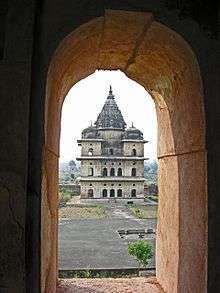Bundela
The Bundelas are a Rajput clan of central India. The families belonging to this clan ruled several small states in the Bundelkhand region from the 16th century.

Mythical origin
The mythical accounts of the Bundela dynasties trace their ancestry to the Suryavansha (solar dynasty). An example of such an account is that of Gorelal or Lal Kavi (c. 1700 CE), who composed a poetic biography of the Bundela king Chhatrasal.[1]
The account goes like this: Brahma originated from Vishnu. The descendants of Brahma were: Marichi, Kashyapa, Surya (the sun; son of Kashyapa and Aditi), Ikshavaku, Dilipa, Raghu, Aja, Dasharatha, Ramachandra, Kusha, Haribrahma, and Vihagaraja. The seventh-generation descendant of Vihagaraja was Kiratdeva, who was the ancestor of Kashi king Virabhadra. The founder of the Bundela dynasty was a descendant of Virabhadra's son Jagdas (also known as Pancham, Devadasa or Hem Karan).[2]
Jagdas was a son of Virabhadra's junior queen. After being denied a share in the Kashi kingdom by the four sons of the elder queen, he came to the shrine of the goddess Vindhyavasini. There, he engaged in a long tapasya to seek the goddess' blessings. After failing to evoke response, he decided to sacrifice his head to the deity. As soon as the first drop of his blood fell on the ground, the goddess appeared before him. She declared that his son, a brave hero and a future ruler, would appear from the drop of the blood. This son – Bundela – was named after the drop (bund).[3] The Bundela dynasties worshipped the Vindhyavasini as their kuladevi (family deity).[4]
Expansion legends
According to Bundela legends, Jagdas' descendant Arjunpal was the ruler of Mahoni. His eldest son Birpal succeeded him as the king of Mahoni, although his younger son Sohanpal was the best warrior. To get his share of the kingdom, Sohanpal sought help from Naga (alias Hurmat Singh), the Khangar ruler of Kurar (Kundar). Naga demanded a matrimonial alliance in return. When Sohanpal refused, Naga tried to detain him and forcibly agree him to the condition. Sohanpal escaped, and unsuccessfully sought help from the Chauhans, the Salingars, and the Kachwahas. Ultimately, a Panwar chief named Panpal (or Punyapal) agreed to help him. Their joint army defeated Naga in 1288 CE.[5] Sohanpal killed all the Khangar men in the fort, but spared the babies on the condition that the Khangars would serve as the servants of the Bundelas.[6] Sohanpal became the king of Kurar, and his daughter married Panpal.[5]
The Bundelas formed "milk brotherhood" with the Ahirs. The Ahir wet nurses (dudh ma or "milk mothers") nourished the Bundela princes with their milk, while the Ahir men served as warriors in the Bundela armies.[7]
Historical kingdoms
Rudra Pratap Singh (reigned 1501-1531 CE), said to be a descendant of Sohanpal, moved his capital from Garh Kundar to Orchha in 1531 CE.[8] The Orchha State was the parent Bundela kingdom. Datia State (1626 CE) and Panna State (1657 CE) separated from the Orchha State. After the death of Panna's founder Chhatrasal in 1731, Ajaigarh State, Bijawar State and Charkhari State separated from Panna.[9] The official records of the Chhatarpur State also mentioned the caste of its rulers as "Panwar Bundela". Its founder was a Panwar, who was in service of the Bundela ruler of Panna State until 1785 CE.[9]
The Bundelkhand ("Bundela domain") region was named after the Bundelas.[10]
The different Bundela chieftains of Bundelkhand often fought against each other which the Mughals often took advantage of.[11]
See also
References
- Jain 2002, p. 11.
- Jain 2002, pp. 9-11.
- Jain 2002, p. 11-12.
- Jain 2002, p. 13.
- Jain 2002, pp. 14-15.
- Jain 2002, p. 27.
- Jain 2002, p. 30.
- K. K. Kusuman (1990). A Panorama of Indian Culture: Professor A. Sreedhara Menon Felicitation Volume. Mittal Publications. p. 151. ISBN 978-81-7099-214-1.
- Jain 2002, p. 3.
- Jain 2002, p. 1.
- Amir Ahmad (2005–2006). "THE BUNDELA REVOLTS DURING THE MUGHAL PERIOD: A DYNASTIC AFFAIR". Proceedings of the Indian History Congress. 66: 438–445. JSTOR 44145860.
Bibliography
- Jain, Ravindra K. (2002). Between History and Legend: Status and Power in Bundelkhand. Orient Blackswan. ISBN 978-81-250-2194-0.CS1 maint: ref=harv (link)